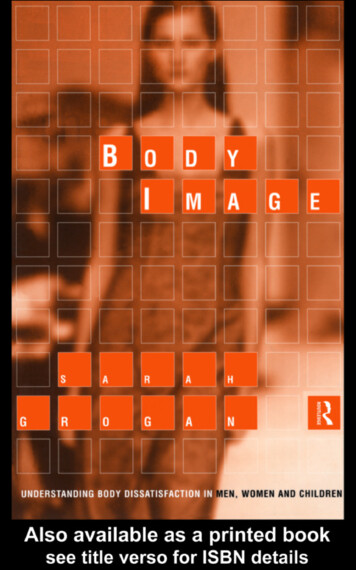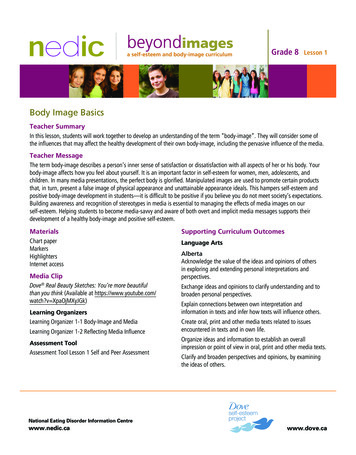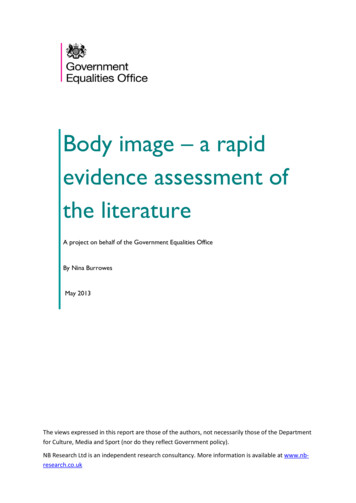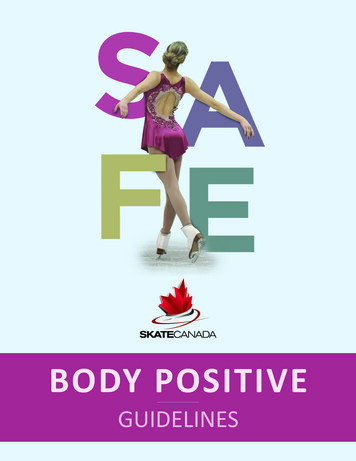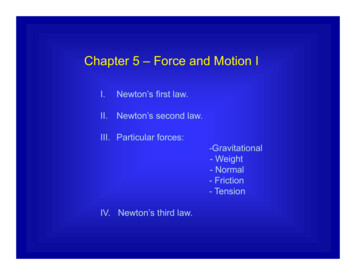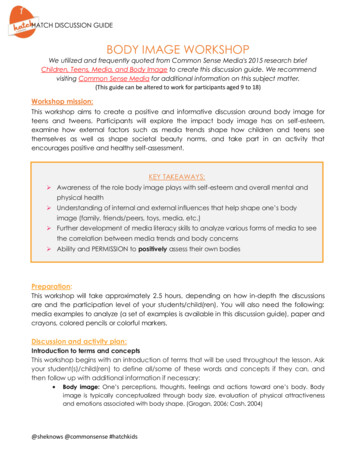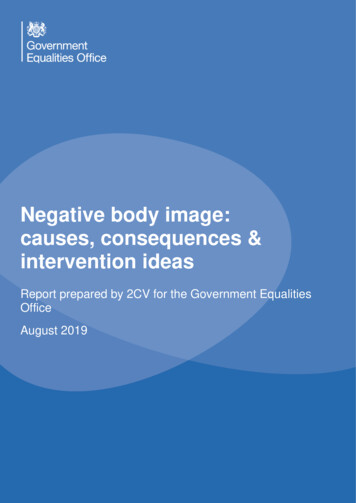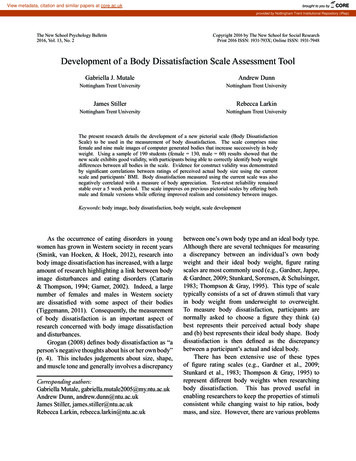
Transcription
View metadata, citation and similar papers at core.ac.ukbrought to you byCOREprovided by Nottingham Trent Institutional Repository (IRep)The New School Psychology Bulletin2016, Vol. 13, No. 2Copyright 2016 by The New School for Social ResearchPrint 2016 ISSN: 1931-793X; Online ISSN: 1931-7948Development of a Body Dissatisfaction Scale Assessment ToolGabriella J. MutaleNottingham Trent UniversityJames StillerNottingham Trent UniversityAndrew DunnNottingham Trent UniversityRebecca LarkinNottingham Trent UniversityThe present research details the development of a new pictorial scale (Body DissatisfactionScale) to be used in the measurement of body dissatisfaction. The scale comprises ninefemale and nine male images of computer generated bodies that increase successively in bodyweight. Using a sample of 190 students (female 130, male 60) results showed that thenew scale exhibits good validity, with participants being able to correctly identify body weightdifferences between all bodies in the scale. Evidence for construct validity was demonstratedby significant correlations between ratings of perceived actual body size using the currentscale and participants’ BMI. Body dissatisfaction measured using the current scale was alsonegatively correlated with a measure of body appreciation. Test-retest reliability remainedstable over a 5 week period. The scale improves on previous pictorial scales by offering bothmale and female versions while offering improved realism and consistency between images.Keywords: body image, body dissatisfaction, body weight, scale developmentAs the occurrence of eating disorders in youngwomen has grown in Western society in recent years(Smink, van Hoeken, & Hoek, 2012), research intobody image dissatisfaction has increased, with a largeamount of research highlighting a link between bodyimage disturbances and eating disorders (Cattarin& Thompson, 1994; Garner, 2002). Indeed, a largenumber of females and males in Western societyare dissatisfied with some aspect of their bodies(Tiggemann, 2011). Consequently, the measurementof body dissatisfaction is an important aspect ofresearch concerned with body image dissatisfactionand disturbances.Grogan (2008) defines body dissatisfaction as “aperson’s negative thoughts about his or her own body”(p. 4). This includes judgements about size, shape,and muscle tone and generally involves a discrepancyCorresponding authors:Gabriella Mutale, gabriella.mutale2005@my.ntu.ac.ukAndrew Dunn, andrew.dunn@ntu.ac.ukJames Stiller, james.stiller@ntu.ac.ukRebecca Larkin, rebecca.larkin@ntu.ac.ukbetween one’s own body type and an ideal body type.Although there are several techniques for measuringa discrepancy between an individual’s own bodyweight and their ideal body weight, figure ratingscales are most commonly used (e.g., Gardner, Jappe,& Gardner, 2009; Stunkard, Sorensen, & Schulsinger,1983; Thompson & Gray, 1995). This type of scaletypically consists of a set of drawn stimuli that varyin body weight from underweight to overweight.To measure body dissatisfaction, participants arenormally asked to choose a figure they think (a)best represents their perceived actual body shapeand (b) best represents their ideal body shape. Bodydissatisfaction is then defined as the discrepancybetween a participant’s actual and ideal body.There has been extensive use of these typesof figure rating scales (e.g., Gardner et al., 2009;Stunkard et al., 1983; Thompson & Gray, 1995) torepresent different body weights when researchingbody dissatisfaction. This has proved useful inenabling researchers to keep the properties of stimuliconsistent while changing waist to hip ratios, bodymass, and size. However, there are various problems
48MUTALE, DUNN, STILLER, & LARKINwith these types of stimuli. For example, linedrawn figures have been said to lack realism andecological validity and can therefore often appearunrealistic (Tassinary & Hansen, 1998). Thompsonand Gray (1995) noted that previous line drawn scaleshave figures with disproportionate arms and legs,differential thickness between right and left arms, ora lack of separation between the arms and bodies inobese drawings. This has led to further criticism ofresearch into physical attraction (e.g., Singh, 1993;Swami, Furnham, & Joshi, 2008) that has previouslyrelied on line-drawn stimuli (Bateson, Cornelissen, &Tovée, 2007; Gardner, Friedman, & Jackson, 1998).Often, line-drawn figures (e.g., Singh, 1993) that varyin waist to hip ratio (WHR) are modified by alteringthe width of the torso, but this also changes apparentBody Mass Index (BMI), meaning it is not possibleto say whether attractiveness ratings are made onthe basis of WHR, BMI or both. In addition, thesefigures are usually drawn by a professional artist (e.g.,Thompson & Gray, 1995). Therefore, the increasein body weight between figures is subject to theartist’s estimation of increase in body weight, ratherthan a metrically precise increment. This results ininconsistent size differences between successivefigures (Gardner et al., 1998).To address some of the previous problemswith the measurement of figural stimuli, Gardneret al. (2009) developed a line-drawn figure ratingscale where the bodies were based on real bodydimensions. However, although these bodies can besaid to change in size, the way real bodies do, usingline-drawn stimuli still lacks realism (Tassinary &Hansen, 1998). Therefore, to address these issueswith line-drawn stimuli, Swami, Salem, Furnham,and Tovée (2008a) developed The PhotographicFigure Rating Scale (PFRS). This scale comprises 10photographic images of real women varying in BMIfrom extremely thin to obese and has been used toassess body dissatisfaction.Although the PFRS offers improvement on linedrawn scales by using images of real bodies, this cancause problems when trying to maintain consistency.For example, it has been noted that the bodies usedin the PFRS vary in leg length (Swami et al., 2008a).This is problematic since leg to body ratio has beenshown to affect attractiveness preferences in femalebodies (Swami, Einon, & Furnham, 2006) and,therefore, when being used in the measurement ofbody dissatisfaction, some bodies may appear moreattractive not because of their size but because of amore appealing leg to body ratio. In addition, thebodies used in the PFRS had their faces obscured inorder to maintain consistency across images. It couldbe argued that this also reduces the ecological validityof the images as bodies in real life are rarely seenwithout faces. Most importantly, there is currently nomale version of the PFRS.Accordingly, our goal was to develop and reportthe psychometric evaluation of a new pictorialmeasure of body image that has two comparableversions which can be used with both females andmales. The Body Dissatisfaction Scale (BDS)comprises images of computer generated bodies.Using computer generated bodies improves on thedrawn stimuli used in previous figure rating scales(e.g., Stunkard et al., 1983; Thompson & Gray, 1995).Computer generated images are more realistic andlife-like while also allowing for accurate control ofsize and shape differences between successive bodies.Using computer generated stimuli allows variationin body proportions, such as leg to body ratio, to becontrolled for. This cannot be controlled for whenusing photographic images. It also gives greatercontrol over variation in physical characteristicslike skin and facial features (identity). Therefore, asskin and facial features can be controlled, there is noneed to obscure faces in the BDS, and presenting abody with the face will likely increase the ecologicalvalidity of the scale.Although using computer generated stimulican never be completely ecologically valid, it canreduce some of the problems found when usingphotographic images and is especially useful in anexperimental setting where greater control is needed.Indeed, the use of computer generated stimuli isbeing used increasingly in body perception research(e.g., Crossley, Cornelissen, & Tovée, 2012; Tovée,Edmonds, & Vuong, 2012). However, there iscurrently no pictorial scale using computer generatedstimuli that has been psychometrically evaluated formeasuring body dissatisfaction. This study is thefirst to develop and test a scale using this new type ofcomputer generated stimuli.
DEVELOPMENT OF A BODY DISSATISFACTION SCALEThe aim of our research was to examine thevalidity and test-retest reliability of both the femaleand male versions of the BDS. Similar to previousresearch (e.g., Swami et al., 2008a; Thompson &Gray, 1995), the scale was initially tested for validityby assessing the extent to which participants couldsuccessfully distinguish the size differences betweenthe nine bodies. It was expected that, for the scaleto be valid, participants would be able to do thissuccessfully. In line with previous research (Swamiet al., 2008a), construct validity was assessed byexamining the correlation between the BDS and ameasure of positive body image. It was hypothesizedthat these variables would be negatively correlated.In addition, the correlation between participants’perceived actual body size ratings and their BodyMass Index (BMI) was also used to asses constructvalidity. It was predicted that there would be apositive correlation between participants’ BMIand their perceived actual body. Finally, test-retestreliability was examined by the correlation of bodydissatisfaction scores from a first and second testing,and this was expected to be positively correlated toshow reliability.MethodParticipantsParticipants were 130 females and 60 males.They were all Psychology students from NottinghamTrent University. Participants were given researchcredits in exchange for taking part in the research.Of the female participants, 76.9% were WhiteEuropean, 10.8% were of Asian descent, 7.7%had mixed ethnicity, and 4.6% were of AfricanCaribbean descent. Of the male participants, 83.3%were White European, 8.3% were of Asian descent,5.1% were of African Caribbean descent, and 3.3%were of mixed ethnicity.MaterialsBody Dissatisfaction Scale (BDS). The scalewas developed by creating an average sized bodyusing DAZ Studio 4 software (www.daz3d.com).Using this software the average sized body wassystematically altered to create 4 bodies which weresuccessively thinner than the original body and 449bodies which were larger than the original body.Thus, nine bodies were created in total which rangefrom extremely thin to obese. This was done for boththe female (see Appendix A1) and male bodies (seeAppendix A2), creating two versions of the scale.Following Crossley et al. (2012), the bodies,without clothing, were then exported out of DAZstudio into 3ds Max (www. autodesk.com). 3ds Maxis able to estimate the height of the body in real worldmeasurements (cms). In addition, 3ds Max calculatesthe volume of the body. Once volume is known theweight of the body can be estimated by multiplyingthe density of either the average young female body(1.04 g/cm³) or the average young male body (1.06g/cm³). This enables the BMI of each body to becalculated by dividing the weight (kg) by the height(m) squared (see Appendix B for measurements,weights, and BMIs). The BMIs of the nine bodiesin both the female and male scale range fromunderweight to obese: bodies 1-3 are underweight,bodies 4-6 are in the normal range and bodies 7-9 areoverweight/obese.All the bodies are depicted at a 25 degree angleto enable more visual information about the 3Dshape of the body to be made available. This givesa more realistic portrayal of the human body shapethat would not be achieved by using simple frontview bodies. Gardner et al. (2009) recommendedomitting facial and body features in pictorial stimulithat reflect obvious Caucasian ethnicity. However,since removing or obscuring the facial features wouldreduce the ecological validity of the images, thebodies are instead presented in grey scale and withouthair to minimize the effects of race or ethnicity. Itis therefore thought that when presenting the bodiesin this way there would be little effects of perceivedethnicity. All bodies are depicted wearing blackshorts and a T-shirt, so the size and shape of the bodyis clearly visible.The BDS scale can be used to measure bodydissatisfaction by numbering the bodies from 1 to 9(in ascending order of size); each body is scored asone body unit. Participants are asked to choose thebody they would most like to look like (ideal) andthe body they thought was closest to their perceivedactual body shape (actual). The discrepancy betweenthe participant’s selected actual and ideal body was
50MUTALE, DUNN, STILLER, & LARKINthe participant’s body dissatisfaction score. Forexample, if a participant chose body number 5 astheir actual body and body number 2 as their idealbody, their body dissatisfaction score would be 3. Ahigher score means a greater discrepancy betweenperceived ideal and actual body chosen, meaninggreater dissatisfaction. This difference score does notreflect the direction of the body dissatisfaction andparticipants may have chosen an ideal body that wasthinner or heavier than their chosen actual body. Thehighest body dissatisfaction score a participant couldreceive would be 8 if they selected body 1 and body9. If a participant has no body dissatisfaction, i.e.,they selected the same number body for both theirperceived ideal and actual body, they would have ascore of zero.Body Appreciation Scale (BAS; Avalos, Tylka, &Wood-Barcalow, 2005). The BAS comprises 13 itemswhich are intended to measure body appreciation.Items are statements for which participants are askedto select a response. Some example items from theBAS include “I feel that my body has at least somegood qualities” and “My self-worth is independent ofmy body shape or weight.” Items are scored on a 5point scale (1 never, 2 seldom, 3 sometimes,4 often, 5 always) and are averaged to obtainan overall body appreciation score. A higher scoreindicates higher body appreciation. The BAS hasbeen shown to have good internal consistency (α .94). Construct validity was demonstrated bya positive correlation with a tendency to evaluateone’s appearance favorably (r .68), and negativecorrelations with body preoccupation (r -.79)and eating disorder symptomatology (r -.60). Inaddition, test-retest reliability was found to be good(r .90) over a 3 week period.Initial validation task. Following Swami et al.’s(2008a) and Thompson and Gray’s (1995) validationof the PFRS and the CDFRS, the BDS was tested forvalidity by assessing the extent to which participantscould successfully identify the body weight differencesbetween the nine bodies. In Swami et al. (2008a) andThompson and Gray (1995), participants were askedto order the images from thinnest to heaviest and thepercentage of correctly positioned bodies was used toestablish validity. In the current research, participantswere given a two alternative forced choice (2AFC)task in which participants were presented with pairsof bodies. Participants had to decide which bodythey thought was the thinnest body out of the pair.All possible pair combinations were presented ina random order. The percentage of combinationswhere the participants correctly identified the thinnestbody was used to assess the ability of participants todistinguish the body weight differences between allbodies and therefore validity of the BDS.In order for the scale to be valid it is essential thatparticipants are able to see that all the bodies vary inbody weight. It is not sufficient to tell participantsthat bodies are presented from underweight to obesebefore the scale is used. In addition, this means thatin further research the bodies do not need to alwayshave to be presented from underweight to obeseand could be presented in a variety of ways if it isestablished that participants can distinguish weightdifferences between all the bodies.Test-retest reliability. Test-retest reliability wasexamined by the correlation of body dissatisfactionscores from the initial testing and then again afterfive weeks. There is no evidence to establish thatone particular time period is best for reliabilitytesting in pictorial body dissatisfaction measurementscales. The length of time does affect the reliabilityof a measure to the extent that the first testing mayinfluence the second testing. Previous studies haveused one week (Thompson & Gray 1995) and threeweeks (Swami et al., 2008a). The current researchchose five weeks as it seemed a suitable amount oftime for the first testing to no longer have an effect onthe second testing.Demographics. Participants were also askedtheir age, sex, ethnic origin, and self-reported heightand weight. Height and weight were used to calculateeach participant’s BMI.ProcedureParticipants were presented with the bodiesas a scale on paper, with images going from left toright, from underweight to obese so as to measuretheir perceived body dissatisfaction. Bodies werenumbered from 1 to 9 (in ascending order of size) andeach body is scored as one body unit. Participantswere asked to choose the body they would most liketo look like (ideal) and the body they thought was
DEVELOPMENT OF A BODY DISSATISFACTION SCALEclosest to their perceived actual body shape (actual).This was a categorical judgment and participantscould only choose one body each time. Femaleparticipants were presented with the female versionof the scale and male participants were administeredthe male version.Participants were then given the 2AFC taskto complete. Participants completed this task inSuperLab 4.5 (www.superlab.com) on a 44.3 x 25.4cm screen. Participants had to decide which bodythey thought was the thinnest body out of each pair.Five weeks after the initial test, participants wereinvited to use the new rating scale to measure theirbody image again. Of the original sample, 64 femaleparticipants and 20 male participants returned tocomplete the scale for a second time.51Table 1Female Participants Mean Scores on all MeasuresMSDPerceived actual body score5.581.31Perceived ideal body score4.081.0Body dissatisfaction score1.61.90BAS score3.44.62BMI23.13.50Table 2Male Participants Mean Scores on all MeasuresMSDPerceived actual body score5.071.54Perceived ideal body score4.90.82Body dissatisfaction score1.49.82Female VersionBAS score3.54.64Descriptive statistics. The descriptive statisticsfor the female participants are presented in Table 1.Initial validation. Participants were assessedon their performance on the 2AFC validation task.Same body pairings were removed from the analysis,meaning 72 pair combinations for each participantwere analyzed. Due to a computer error, two of thepair combinations were displayed incorrectly for 30of the participants and therefore the responses forthese combinations were removed from the analysis.The results showed that on average participantswere able to correctly identify the thinnest body97.63% (SD 2.44) of the time. A chi-square analysisshowed that amount of times participants correctlyidentified the thinnest body was significantly higherthan chance χ2(1, N 130) 8440.82, p .001. Thisvalidation task was conducted as to attain whetherparticipants were able identify the thinnest bodyout of each pair and therefore detect body weightdifferences between the bodies. The high percentagecorrect found here suggests that participants areaccurately able to detect the body weight differencesbetween the nine bodies.Construct validity. Validity was assessed by thecorrelation between body dissatisfaction scores onthe BDS and body appreciation scores on the BAS.Results showed a significant negative correlation,BMI24.123.83Resultsr(128) -.60, p .001, providing evidence of constructvalidity. To provide further validation, the correlationbetween participants’ ratings of their perceived actualbody size and their BMI was assessed. This wasalso found to be significant, r(128) .77, p .001,suggesting that the scale can be used to accuratelyassess perception of one’s own body size.Test-retest reliability. The correlations betweenscores for perceived actual body, ideal body and bodydissatisfaction from the first testing and five weeksafter were analyzed for test-retest reliability. Thesewere all found to be significant: perceived actualbody, r(62) 0.81, p .001; ideal body, r(62) 0.89,p .001; and body dissatisfaction, r(62) 0.82, p .001. Scores obtained at the first and second testingwere highly correlated, suggesting that the scale is areliable measure of body dissatisfaction.Male VersionDescriptive statistics. The descriptive statistics forthe male participant sample are presented in Table 2.Initial validation. Participants were assessed ontheir performance in the 2AFC validation task. Intotal, 72 pair combinations were analyzed for each
52MUTALE, DUNN, STILLER, & LARKINparticipant to identify if participants had correctlyselected the thinnest body out of each pair. Due toa computer error, one of the pair combinations wasdisplayed incorrectly for seven of the participants andtherefore the responses for these combinations wereremoved from the analysis.Results showed that participants were able tocorrectly select the thinnest body 98.04% (SD 1.82)of the time when the bodies were presented in pairs.A chi-square analysis showed that amount of timesparticipants correctly identified the thinnest bodywas significantly higher than chance χ2(1, N 60) 3980.70, p .001. Being able to correctly identifythe thinnest body out of each pair of bodies suggeststhat body weight differences between the nine malebodies are easily identifiable.Construct validity.A significant negativecorrelation was found between body dissatisfactionon the BDS and body appreciation scores, r(57) -.46, p .001, providing evidence of constructvalidity. The correlation between participants’ ratingsof their perceived actual body size and their BMI wasalso found to be significant, r(57) 0.83, p .001,providing further validation.Test-retest reliability. To examine test-retestreliability, original scores for perceived actual body,ideal body, and body dissatisfaction were correlatedwith scores from five weeks after the initial testing.All three correlations were found to be significant:perceived actual body, r(18) 0.96 p .001; idealbody, r(18) 0.88 p .001; and body dissatisfaction,r(18) 0.97 p .001.DiscussionThe results of the present research suggest thatboth the male and female version of the BDS exhibitgood construct validity and test-retest reliability over afive-week period. It would appear that participants caneasily detect the subtle differences in size between thenine bodies on the scale. The significant correlationswith the BAS suggest that both the female and maleversion of the BDS have good construct validity.Perceived actual body size was highly correlated withparticipants BMI for both male and female versions,which indicates that the BDS is a useful tool in assessingperception of one’s own body size and provides furtherevidence of construct validity.The findings support the use of the BDS in bodyimage measurement for females and males. Thecurrent scale offers improvement on scales whichhave used line-drawn stimuli (e.g., Stunkard et al.,1983; Thompson & Gray, 2005) by offering greaterrealism and providing more life-like figures. Byusing computer generated figures, it also avoidsthe problems associated with using images of realpeople (e.g., PFRS), such as biases in judgementsassociated with certain racial groups. It also controlsfor unwanted variation in body part ratios, inherent inreal human beings both across and within the sexes.Another advantage of using the BDS is that itis time efficient and easy to administer either in adigital or paper format. A future version of the scalewhere the images are rotated and presented in threedimensional formats could be developed using thesame software. The use of more life-like computergenerated stimuli, like the bodies used in the BDS, isalso particularly useful as it allows for the presentationof stimuli in more realistic settings, which could notbe achieved with line-drawn stimuli. Therefore, thecurrent stimuli is not limited to the use of imagessimply being presented in isolation. Future researchcould see the bodies, for example, being presentedagainst various computer generated backgrounds orsettings to allow for a more realistic presentation.Although the current research provides a maleversion of the scale that is directly comparable with thefemale version, it has been questioned if bodyweightis a strong predictor of physical attractiveness inmales. Some research has suggested that upperbody muscularity is a more important indicator ofattractiveness (Maisey, Vale, Cornelissen, & Tovée,1999; Swami & Tovée, 2005; Swami & Tovée, 2008).Therefore, a male version of the scale which variesin the muscularity of the body shape may be useful.Notwithstanding muscularity, BMI does appear to bea significant predictor of male physical attractiveness(Maisey et al., 1999). Males are concerned with theirbody weight (Pope, Phillips, & Olivardia, 2000),with research suggesting around half wanting to loseweight and half wanting to gain muscle (Drewnowski& Yee, 1987). Therefore, it would seem that bodyweight is still an important component of perceivedbody dissatisfaction in males.In addition, a male version of the scale which
DEVELOPMENT OF A BODY DISSATISFACTION SCALEvaried in muscularity would not be directly comparablewith the female version. The stimuli in the BDS, likethe PFRS, can also be used in an experimental settingto measure attractiveness and health preferences forbody weight (e.g., Swami & Tovée, 2006). In thisway the stimuli can be used to ask participants whichbody they find most attractive and healthy. In this typeof experiment, it would be necessary to have both amale and female version of the scale that both variedin BMI to ensure the results were directly comparablewith each other. Although males and females may notbe equally concerned about their body weight, whenmeasuring body dissatisfaction in an experimentalsetting it is extremely useful to have a measure that isidentical for males and females. Therefore, althougha version of the male scale that varied in muscularitywould be useful, the current version of the male scaleis necessary.One limitation of the current research is that thesample was larger for female participants than for maleparticipants, potentially suggesting that the resultsare more reliable for the female sample. Therefore,findings of the male version should be treated withmore caution than the female version. However, themale version of the scale has good face validity andappears to be measuring body dissatisfaction. A-prioripower analysis is useful in achieving a reliablesample size on which to judge statistical effects.However, selecting an appropriate sample size andcalculating power is complex (see Baguley, 2012;Hoenig & Heisey, 2001). Post-hoc power analysesare particularly problematic because such analysestend to involve transforming the p-values of theeffects being explored. This is problematic because itis paradoxical, as it would involve using significant ornon-significant p-values to confirm that a given effectis (accordingly) significant or non-significant (seeHoenig & Heisey, 2001; Thomas, 1997). Therefore,it was decided not to run and report post-hoc poweranalyses. The apparent strength of the correlationsand the near ceiling performance on the repeatedmeasures 2AFC body detection task are used insteadas indicators of sufficient power for both the femaleand male version. Consequently, this does not meanthat the male version should not be used, especiallysince, as mentioned, there is currently a lack of scalesthat have both female and male versions.53A further limitation is the use of an opportunitysample, meaning the participants were all students,which is not representative of the population as a whole.As this scale was primarily being developed to be usedin a set of experiments with students, it is certainlyvalid to be used in the context for which it is intended.Further research could aim to validate the scale with amore diverse sample. In addition, it could be arguedthat using self-reported weight and height to calculateBMI is not as accurate as using the actual weight andheight of participants. However, previous research hassuggested that self-report measures of weight and heightare highly correlated with participants’ actual weight andheight (Spencer, Appleby, Davey, & Key, 2001), and it istime consuming to collect the actual weight and heightof participants. Therefore, using self-report measuresis a more time efficient method. Finally, althoughthe stimuli used are more life-like in appearancethan previous line drawn stimuli (e.g., Thompson &Gray, 1995), computer generated stimuli may neverbe as ecologically valid as using real life images.Nonetheless, given the problems with maintainingcontrol and consistency over photographic stimuli,computer generated bodies provide a useful alternative,particularly for researchers wanting to measure bodydissatisfaction in an experimental setting.Future research should aim to develop andvalidate a version of the BDS so that it can besuccessfully used with children.Body imagemeasurement with young children can be particularlydifficult. As a consequence, researchers often usepictorial scales as other measures can be too complex,placing increased cognitive demands on youngerchildren. However, pictorial scales in this area arelimited to line-drawings (e.g., Collins, 1991) whichhave similar methodological problems to line drawnstimuli used with adults. A version of the BDS thatcould be used with children would be useful for theassessment of body dissatisfaction in young children.Future research should also aim to further validate thescale and demonstrate its reliability.In conclusi
body image dissatisfaction has increased, with a large amount of research highlighting a link between body image disturbances and eating disorders (Cattarin & Thompson, 1994; Garner, 2002). Indeed, a large number of females and males in Western society are dissatisfied with some aspect
